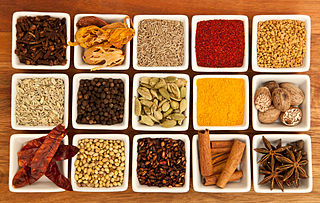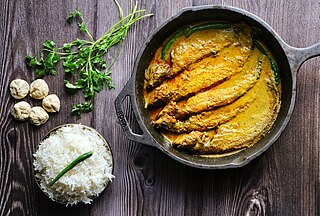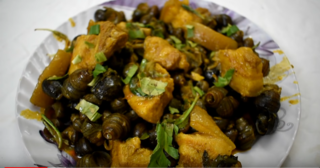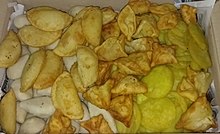
Indian cuisine consists of a variety of regional and traditional cuisines native to India. Given the diversity in soil, climate, culture, ethnic groups, and occupations, these cuisines vary substantially and use locally available spices, herbs, vegetables, and fruits.

Malay cuisine is the traditional food of the ethnic Malays of Southeast Asia, residing in modern-day Malaysia, Indonesia, Singapore, Brunei, Southern Thailand and the Philippines as well as Cocos Islands, Christmas Island, Sri Lanka and South Africa.

Bengali cuisine is the culinary style of Bengal, a region in the eastern part of the Indian subcontinent encompassing Bangladesh and the Indian states of West Bengal, Tripura, as well as the Barak Valley in Assam. The cuisine has been shaped by the region's diverse history and climate. It is known for its varied use of flavours including mustard oil, as well as the spread of its confectioneries and desserts. There is a strong emphasis on rice as a staple, with fish traditionally the most common protein. Freshwater fish are preferred to seafish, although barramundi, known as bhetki, is also common. Although less popular than fish, Bengalis have eaten a variety of meats since pre-colonial times, ranging from pigs and deer to hedgehogs and turtles. In more recent times, lentils have begun to form a significant part of the diet. Many Bengali food traditions draw from social activities, such as adda, or the Mezban.

Rice and curry is a popular dish in Sri Lanka, as well as in the Indian subcontinent.

Sri Lankan cuisine is known for its particular combinations of herbs, spices, fish, vegetables, rices, and fruits. The cuisine is highly centered around many varieties of rice, as well as coconut which is a ubiquitous plant throughout the country. Seafood also plays a significant role in the cuisine, be it fresh fish or preserved fish. As a country that was a hub in the historic oceanic silk road, contact with foreign traders brought new food items and cultural influences in addition to the local traditions of the country's ethnic groups, all of which have helped shape Sri Lankan cuisine. Influences from Indian, Indonesian and Dutch cuisines are most evident with Sri Lankan cuisine sharing close ties to other neighbouring South and Southeast Asian cuisines.

Assamese cuisine is the cuisine of the Indian state of Assam. It is a style of cooking that is a confluence of cooking habits of the hills that favour fermentation and drying as forms of preservation and those from the plains that provide extremely wide variety of fresh vegetables and greens, and an abundance of fish and meat. Both are centred on the main ingredient — rice. It is a mixture of different indigenous styles with considerable regional variations and some external influences. The traditional way of cooking and the cuisine of Assam is very similar to South-East Asian countries such as Thailand, Burma (Myanmar) and others. The cuisine is characterized by very little use of spices, little cooking over fire, and strong flavours due mainly to the use of endemic exotic fruits and vegetables that are either fresh, dried or fermented. Fish is widely used, and birds like duck, pigeon, squab, etc. are very popular, which are often paired with a main vegetable or ingredient; beef used to be eaten before British colonialism, and some continue to do so. Preparations are rarely elaborate. The practice of bhuna, the gentle frying of spices before the addition of the main ingredients so common in Indian cooking, is absent in the cuisine of Assam. The preferred oil for cooking is the pungent mustard oil.

Cuisine of the Indian subcontinent includes the cuisines from the Indian subcontinent comprising the traditional cuisines from Bangladesh, Bhutan, India, the Maldives, Nepal, Pakistan and Sri Lanka.

Bangladeshi cuisine is the national cuisine of Bangladesh. Bangladeshi cuisine has been shaped by the diverse history and river-line geography of Bangladesh. The country has a tropical monsoon climate. The staple of Bangladesh is rice and fish. The majority of Bangladeshi people are ethnic Bengali, who follow Bengali cuisine, with a minority of non-Bengalis with their own unique cuisine. Bangladeshi food has more meat, especially beef, compared to West Bengal.

South Indian cuisine includes the cuisines of the five southern states of India—Andhra Pradesh, Karnataka, Kerala, Tamil Nadu and Telangana—and the union territories of Lakshadweep, Pondicherry, and the Andaman and Nicobar Islands. There are typically vegetarian and non-vegetarian dishes for all five states. Additionally, all regions have typical main dishes, snacks, light meals, desserts, and drinks that are well known in their respective region.

Bhojpuri cuisine is a style of food preparation common among the Bhojpuri people of Indian subcontinent. Bhojpuri foods are mostly mild and tend to be less hot in terms of spices used. The cuisine consists of both vegetable and meat dishes.

Goan cuisine consists of regional foods popular in Goa, an Indian state located along India's west coast on the shore of the Arabian Sea. Rice, seafood, coconut, vegetables, meat, bread, pork and local spices are some of the main ingredients in Goan cuisine. Use of kokum and vinegar is another distinct feature. Goan food is considered incomplete without fish.

Manipuri cuisine refers to the cuisine of Manipur, a state of northeastern India. Daily meals are based on rice, with a few side dishes of vegetables, fish and meat. A meal would usually have a vegetable stew called ensaang or athongba, flavored with dried or fried fish; stir-fried vegetables called kanghou; and a spicy item, which could be morok metpa, iromba, or singju. All piquant side dishes are accompanied by a choice of fresh herbs, collectively called maroi. The base and essence of Meitei cuisine is the fermented fish called ngari. Several dishes of meat, mostly chicken and pork, are cooked with unique recipes. As a result of religious taboos, however, the Meitei Pangals do not cook the latter.

Malaysian Indian cuisine, or the cooking of the ethnic Indian communities in Malaysia, consists of adaptations of authentic dishes from India, as well as original creations inspired by the diverse food culture of Malaysia. Because the vast majority of Malaysia's Indian community are of South Indian descent, and are mostly ethnic Tamils who are descendants of immigrants from a historical region which consists of the modern Indian state of Tamil Nadu and Sri Lanka's Northern Province, much of Malaysian Indian cuisine is predominantly South Indian inspired in character and taste. A typical Malaysian Indian dish is likely to be redolent with curry leaves, whole and powdered spice, and contains fresh coconut in various forms. Ghee is still widely used for cooking, although vegetable oils and refined palm oils are now commonplace in home kitchens. Before a meal it is customary to wash hands as cutlery is often not used while eating, with the exception of a serving spoon for each respective dish.

Mizo cuisine is the traditional cuisine of the Mizo people of Mizoram, India. Mizos are traditionally rice eaters.

Soft Khichuri, also known as Norom Kisuri is one kind of rice-based meal which is similar in consistency to porridge, a popular dish in the Sylhet region of Bangladesh. It is a traditional food in Sylheti cuisine that is served most dinner tables during the holy month of Ramadan. Being a staple food for iftar, Soft Khichuri at home and Akhni for serving the guest is a tradition of Sylhet. Aromatic rice mixing with various spices including ghee, kalozira and fenugreek to cook Kisuri. There are two types of Soft Khichuri; white soft khichuri (jau/zau) and yellow soft khichuri (kisuri). Chana, Chickpea, piyaju, Bakarkhani, potato chops, egg chops, Beguni, vegetables and leaf pakora, Jalebi, Sharbat, phirni are the side dishes of Sylheti Iftar items. Among the sweetmeats, Sylhet's specialty is Imarti. It is specially made of without any food color for Iftari. Though it looks like jilapi, there is a difference between them in size and taste.

Chunga pitha, also known as chungapura pitha, is a traditional rice cake (pitha) originating in the Sylhet region of Bangladesh. Though its main ingredients are bamboo and glutinous (sticky) rice, it is also made with binni rice, milk, sugar, coconut, and rice powder. This unique delicacy is prepared when sticky rice is stuffed inside young bamboo and smoke slowly. It is popularly known as a distinct and traditional food in Bengali cuisine.
Kala bhuna is a meat curry made of beef or mutton, originated in Chittagong, Bangladesh. Different types of spices are needed to prepare this traditional dish of Chittagong. In Bengali, the word kala or kalo means black and bhuna means deep fry. Kala bhuna gets its name from its appearance, as the meat goes blackish during a long process of deep frying it with a plenty of spices. It has become popular also in other Bangladeshi cities like Sylhet, Khulna, Dhaka etc. Nowadays, this dish is also a favorite delicacy in mezbans, weddings, eids and in sehri or iftar during the time of Ramadan. Usually, Kala bhuna is eaten with plain rice, polao, porota, naan or ruti.
Beef Hatkhora or Internationally known as Sylheti Beef; is a Sylheti cuisine consisting of rice, satkara citrus, and beef curry. Whilst having its origins in the Sylhet Division, the dish has now gained popularity across the country and among the British Bangladeshi diaspora in the United Kingdom. At the time of Eid-ul-Adha, it is a famous dish. The presence of a citrus fruit makes the dish unique among Bangladeshi curries in terms of taste and aroma. A soupy variant of the dish is made with the bones of cow feet, and in other variants, the beef is sometimes replaced with fish or other meats.

Hutki shira, Hukoin Shira, Fukoin Shira, Shukoin shira, or shutki shira is a fermented fish curry made with seasonal vegetables, leafy greens, and fish or prawns. It is cooked without oil or fat. The dish is famous in the Sylhet region of Bangladesh and it has many variations.






















